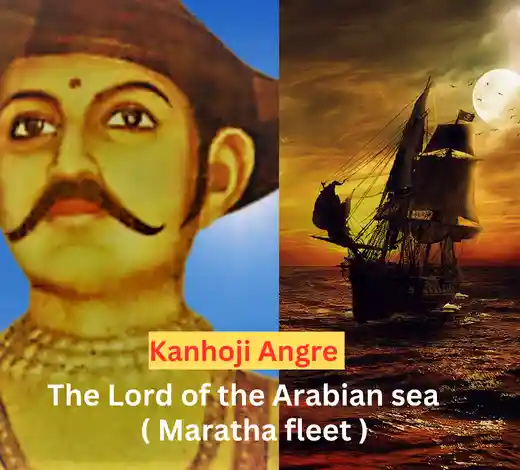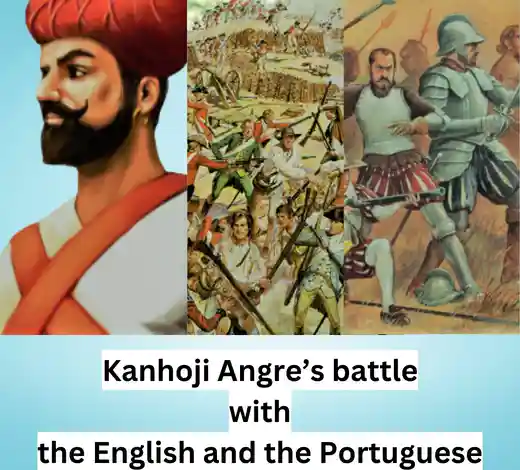Brief Introduction
Kanhoji Angre or Sarkhel Kanhoji Angre was the first major chief of the Maratha Navy after the death of Sidhoji Gujar in 1697 AD. He was widely known as the “ Shivaji of the sea “ and the Lord of Kolaba and neighbouring water .
Fear of Kanhoji’s presence in Western coast was so high that the European Nations and the British ( English ) didn’t want to take any battle with him. He was one of the greatest naval Marathas who had done a great service under the Maratha’s flag.
The Portuguese had given him the title of ” Subedar da Armada do Sivage “ . Kanhoji Angre didn’t leave any stone unturned in seizing the ships which he found against the interest of the Marathas and which could become a threat to the Marathas.
It wasn’t an easy task to take battle against not less than five rivals simultaneously. They were Sidi of Janjira , Savants of Wari, The English of Bombay (British), the Dutch of Vingurla and Portuguese of Goa .
His authority and his work was completely dedicated to the lawfully constituated government. i. e. Marathas
The Dutch, Portuguese and the British had trying to control the sovereignty of the sea route which was against the self-respected Nation. Marathas were very much dedicated to the motherland. So, a nation with pride would never allow to give their control of the movement of their merchant men across the high road of the sea to the foreign countries.
And Kanhoji was doing a phenomenal job in protecting the sovereignty of the nation. His stand was very clear towards his enemies .He didn’t believe in showing sympathy to their enemies when he was on the duty of protecting his motherland .
Kanhoji Angre was affirmed to defend his right against all his neighbourings jointly. His power of defence could be withdrawn when he used to take multiple battles with English ,Portuguese and Dutch at the same timeframe.
The glory of him was that he had never been defeated in any battle. This gives a signal that his infinite power was unstoppable for any of the foreign countries who tried to control the sea route of Bharat.
The Britishers in his wrath used to call him a robber or a pirate. When your enemy has no control in taking a battle with you then they use harsh words to demonise the purity of your soul.
Birth and early life
Kanhoji Angre was born in 1669 AD in a village of Harne, Konkan and was the son of Tukoji Angre who had had served the great Chhatrapati Shivaji Maharaj . He belonged to a Maratha kshatriya family having the ancestral surname of Sankpal . The surname “Angria Or Angre ” , he got from the village Angarvadi where he resided for the longest years.
Kanhoji Angre became the chief commander of the Maratha Navy when Balaji Vishwanath, the founder of the Peshwa family ,was gaining the confidence of Shahuji Maharaja, Grandson of Shivaji Maharaja, through his valour and brilliancy in handling the military power.
He had more than one wife and also had concubines . From them ,he had two legitimate sons – Sekhoji Angre and Sambhaji Angre. He also had illegitimate sons named Tulaji, Manoji ,Yesaji and Dhondji.
Contributions of kanhoji angre in developing the Maratha Navy
The Sidis had started to take advantage of the Mughal occupation of Maharashtra by occupying the mainland after the death of Shivaji Maharaj in April 1680 AD . But they had forgotten the spirit of Marathas to protect their motherland and Kanhoji had stood like a wall in front of them.
It was the responsibility of Kanhoji Angre to drive them back to their Island and protect and recover the lost territories.
To meet this task, it was very much necessary for the Marathas to add more ships and army to rule the sea route. It could only be possible through money and the only source of money left was to save the sovereignty of the sea route by compelling foreign traders to purchase the Cartaz ( licence ) from Kanhoji Angre . This was the same method which was also used by Shivaji and his sons to protect the Sovereignty of the Maratha fleet.
- 1703 AD – Captured a Dutch ship
- 1710 AD – He captured a Dutch sloop
- 1712 AD – Successfully won the battle against Portuguese and Sidis simultaneously.
- 1712 AD – Seizing the English boat
- 1718 AD – Challenged and defeated the English senior Governor Charles Boone
Battles fought by Kanhoji Angre
- The beginning of the war started with the Portuguese when Kanhoji Angre captured pal-of-war which was richly laden and carrying the retired governor of Chaul.
- Another with two manchuas-of-war belonging to the Portuguese fleet of north. One, he captured with 27 Portuguese Prisoners and another one was burnt by him. The fear of Kanhoji was such that merchantmen sailing under the Portuguese used to contribute to kanhoji’s coffers.
- One of the biggest blow to the Portuguese happened in 1712 AD when Kanhoji with his pals attacked a merchant fleet sailing for the port of the north . The fleet was convoyed by two frigates under the command of Luiz da Costa . He captured at least 40 parangues. People who had invested in this Mercantile enterprises had lost everything they had.
- They started to lose their possession on the Mumbai coast. Kanhoji had won this Battle against the Portuguese. He obtained large money from the Portuguese and also levied a contribution on their villages.
- In 1713 AD ,he again attacked a frigate of 34 guns that had just landed the Portuguese force at Chaul.
- In 1712 AD, he captured the governor of Bombay’s armed yacht with another English vessel, the Anne of carwar.
- Even after the release of Shahu from the jail of Mughal, Kanhoji was completely dedicated to Tarabai and hence waged a war against Shahu and extended his territories on the mainland. But he was aware of the fact that he had limited resources to rule the winning land so, he decided to make a peace agreement with Sahu and the English. After getting convinced by Balaji Vishwanath ( father of Peshwa Bajirao ), Kanhoji declared Sahu as his Chhatrapati according to the Treaty of 1714 AD.

Dispute between Kanhoji Angre and the English
To maintain peace with English, in 1713 AD he signed a treaty with English but unfortunately it didn’t last long. In 1715 AD, Kanhoji complained to the new governor of Mumbai Charles Boone ‘ of ill usage in return for the good offices he had done ‘ . Immediately Charles Boone wrote a letter to his senior that this time they are not in a position to stand against Kanhoji. They were basically waiting for the right time to act against him when he became vulnerable.
The negotiation between Kanhoji and the English didn’t go well which resulted in capturing the ships of the English by kanhoji. The distrust and suspicion against the English made him act against them vigorously.
To bring down the act of Kanhoji, again in 1717-1718 AD, the Mumbai Council met him for negotiation but again nothing came out of it. Kanhoji Angre also refused to deliver the ship. Moreover, he captured another ship too, the otter.
This time on 5th April,they decided to destroy Kanhoji’s fleet. The English detained a Shibar which belonged to Angria’s port, alibag . This act of the English multiplied the wrath of Kanhoji.
A letter was sent to Governor, Charles Boone by Kanhoji and it was ” our friendship is over and from now onwards whatever god will give me I will take it ” .
On 17th June 1718 AD, an open war was declared by the English against Kanhoji Angre . Kanhoji also cleared his stand with full determination that not even a single ship of the English will be spared without following the rules of the passport.
Further he added, he would not touch the ships which will belong to Bengal , Madras and Mumbai. Kanhoji’s forts were attacked at least six times by the British after the arrival of governor Charles Boone but every single effort of the English resulted in zero gain .
The governor Charles Boone was of cunning mind. He had already realized that he couldn’t bring Kanhoji to his terms unless some of his principal strongholds were reduced. He tried his best to exploit the strength of Kanhoji by making alliances with others but nothing went in his favour.
The English had tried their best to burn the ghurabs at Vissundroog in November 1719 AD but it was concluded as a futile attempt by them.
To defeat Kanhoji, in 1716 AD, Portuguese shared their hands with Raja of Kolhapur, Sambhaji. But this ally didn’t work as Sambhaji neither had that potential and ability to give tough battles to Kanhoji. So, this diplomatic approach of the Portuguese was a complete failure .

Eventually an alliance was formed between the English and the Portuguese for the joint expedition against kolaba in December 1721 AD. But there was a huge mutual suspicion for each other. The Portuguese were not liking the expansion of the English in Malabar Coast.
Their 1st great suspicion was that the English used to supply artillery and ammunition to Kanhoji and the other one was that the English practices pirates. But still they found it a great opportunity to defeat their common enemy .
Such a new alliance of the English and the Portuguese alerted Kanhoji. To strengthen his position ,he started to enlist new forces. He also took the help and reinforcements from his liege Lord, the Chhatrapati of Satara.
Kanhoji Angre successfully won the battle against the joint ally of the English and the Portuguese. His brilliancy and tactics were far more advanced than the alliance of the two major parties.
In 1724, again the new governor of Mumbai , William Phipps who succeeded Charles Boone, wrote a letter to Kanhoji Angre for peace. In response, Kanhoji put a proposal of exchanging prisoners which was successfully carried out in 1725 AD.
Last three or four years of his life were quite peaceful. He made a decision in 1725 AD of leaving his headquarters and moved to Satara to pay his tribute to his sovereign and liege-Lord.
Death
Kanhoji Angre died on 20th June 1729 in Alibag . He was succeeded by his eldest son Shikhoji Angre without having any dissension with his brothers. Shikhoji had inherited the talent of brilliance in naval from his father Kanhoji Angre.
Related articles you must read for better understanding :
Why did the Marathas lose to Ahmed Shah Abdali | Third battle of Panipat
Top causes for the decline of Marathas empire
Peshwa Bajirao I history | empire builder of Maratha
Maharani Tarabai – A Maratha warrior Queen who protected the Swarajya
